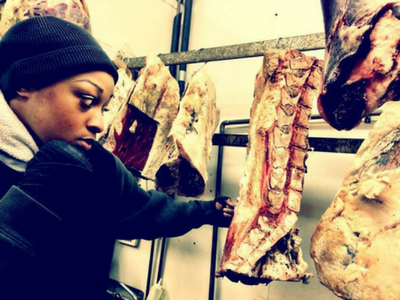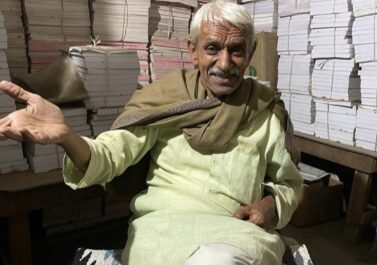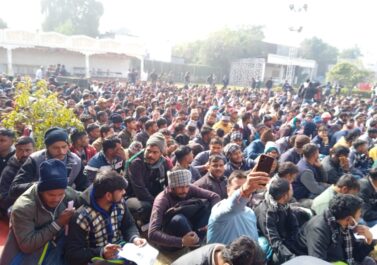(We translated this article from www.wildcat-www.de)
Many workers worldwide who are employed in the meat industry were infected with the corona virus. There were numerous cases in the USA, Canada, Brazil, and Ireland. In Germany it started with 412 cases at Müller-Fleisch in Birkenfeld. There were 131 cases at Vion in Bad Bramstedt, 92 at Westcrown in Dissen, 268 at the Westfleisch company in Coesfeld and 40 in Oer-Erkenschwick, 77 at Wiesenhof in Bogen – and then the major outbreak with at the Tönnies company in Gütersloh – there were over 1,700 cases of corona here. There are also centres of infection in other companies, especially in parcel and logistics centres and large companies where work has continued without interruption. Distance and hygiene measures were not implemented everywhere: at UPS in Langenhagen (156 people infected in mid-June), masks were only available when the first infections became apparent in mid-May, while at Amazon, in some Fulfilment Centres, cramped changing rooms are still being used.
In many of these companies, workers can be blackmailed given their status as part-time, temporary and contract workers. Migrants with different statuses are working In all of these companies, and due to their precarious residency they might not call in sick immediately as soon as they feel unwell. In the meat processing industry, people work close to each other in refrigerated, often humid spaces; there the virus can spread particularly well and is optimally distributed by air conditioning systems. People employed through subcontractors often work six long shifts a week, hard work in alternating day and night shifts. The resulting exhaustion increases susceptibility to infection. Some employers immediately blamed the infections on the workers’ living conditions; they wanted to distract attention from the working conditions. In overcrowded apartments with few washing facilities, infections are indeed easily possible. But why do people have to live like this?
Too pig to fail
The meat industry in Germany has expanded rapidly over the last 30 years, based as it is on cheap and very productive labour. The system of labour contracts that prevails today was in existence before that. Butchers moved as self-employed workers in work gangs from company to company. When the slaughterhouses became larger and regionally merged from the 1970s onwards, some of them remained as permanent staff; they were now pseudo self-employed. The legal responsibility for this was shifted to subcontractors. With this structural change, with the expansion and concentration of meat production, wages and the social standing of the butchers fell, and the job became unpopular. From the 1980s onwards, workers from Eastern Europe were employed in Germany through bilateral quota agreements. On paper, a company in the country of origin ‘sent’ them to Germany to work. In theory, ‘contract work’ [Werkvertrag] means that a certain, clearly defined part of the work is outsourced to a subcontractor. Only the subcontractor is authorised to issue instructions to the workers they employ (usually via temporary employment) and they provide their own foremen and supervisory staff. In some cases, the individual workers are also (seemingly) self-employed, which means that social security contributions, sick pay, etc. are completely out of the picture. Since the full ‘free movement of labour’ for the Eastern European accession countries from 2011 onwards – for Romania and Bulgaria from 2014 – people could be employed directly. But the well-established contract system remained in place, with subcontractors often continuing to pay workers wages and social security contributions at the level of the country of origin. But it is not only about the wage costs. The Eastern European migrants have no prospects in their country of origin, their right of residence is linked to the workplace in the first few years, so they are willing to work hard and do a lot of overtime. They are not supposed to become workers who sometimes work slow, sometimes take sick leave or talk back to the boss. With the subcontractors, the ‘meat barons’ outsource violations of labour law and responsibility for inhuman conditions. On top of that, the fact that subcontractors regularly change is used to conceal who is responsible for what.
Often, only the name of the subcontracting companies change, while the structures and responsible people remain the same. Some subcontractors are suspected to be merely letterbox companies of the major slaughterhouses themselves. The subcontractors are in competition with each other, and many of the big meat corporations hire several. This also suppresses protests: when the NGG [German food workers union] tried to set up a works council for one of the subcontractors, Danish Crown immediately terminated the contract. When this was stopped by the courts, the company simply reduced the number of orders.
The entire system of housing and employment services is entangled with organised crime. Workers are intimidated both inside and outside the company – even with physical violence. They are dependent on the subcontractor because they have to make payments in a kind of debt bondage, and because it is by no means certain that they will get their wages in case of a dispute. Perhaps they themselves have worked illegally at one time and feel they can be blackmailed. In the clutches of this milieu, it becomes more difficult to get advice and support, to get together and to fight back. There are various middlemen between a worker and their wage and each one takes a cut. Similar to the Caporalato [1] in Italy, many people benefit from this system. It starts locally: local municipalities in remote areas have higher tax revenues due to the slaughterhouses; residents can rent or sell properties that would otherwise be empty. In addition, jobs are created for them, for example as technicians or in offices. Often the subcontractors do not pay for all hours worked. They always deduct excessive fees for work clothes, transport and tools from the workers.
Accommodation is linked to the workplace, which is also a means of pressure. The apartments are bought or rented by subcontractors and then rented out to the workers at a high price. They are often run-down shacks that cannot be used for any other purpose. The workers pay 230 – 350 euros for a place to sleep in overcrowded rooms; this brings in a lot of money for the middlemen. At the western border of North Rhine-Westphalia the whole thing is taken to extremes. The subcontractors use cheap housing in the impoverished, deserted areas on the German side, spread over many small villages. Every day they drive the workers to slaughterhouses in the Netherlands, where it is illegal for employers to act as landlords of their own workers.
Workers
There are no exact figures. The NGG estimates that far more than 40,000 people work in meat processing plants via work contracts and subcontractors. They come from Poland, Hungary, Romania, Bulgaria, the Ukraine, Moldova, and for a few years now, there have also been also refugees from the Middle East or Africa working in the sector. They account for 50-90% of the workforce. The proportion of women in some companies is 40%. Many hope to be able to use the job as a springboard to get residency in Germany. Even the minimum wage is very high compared to the opportunities in their home country. Many of them support their families, many of them want to catch up. Only few manage to settle down in one place for a longer period of time, to learn German, to get out of the hard and shitty jobs and even then, often only after many years. Those who have come from Poland and are still doing this type of work might now have one of the better jobs and perhaps ‘live’ here too, in their own accommodation.
In general workers work till they are exhausted. There is little opportunity to relax. Often they have physical and psychological problems – injuries and damage due to being overworked are only the beginning. Many drink, even at work. They have to endure the hard work and are allowed to waste the meat by cutting it wrongly. The employers are dependent on a certain stability in the workforce and on finding suitable people. Even if trained butchers are not used for all jobs, they need experience. Robots are not clever enough for such jobs, and increased automation would also result in a reduction of the product range.
The workers show their displeasure with the conditions mainly by leaving, often for Scandinavia. In some cases, workers have collectively threatened to leave in order to impose improvements. Employers have to go to increasingly distant places to find people. And they have had to improve conditions in recent years, even if they are still shitty. In 2014, the NGG concluded a collective agreement for a minimum wage of 7.75 euros initially, which was also explicitly to be paid by subcontractors based abroad. Today, the statutory minimum wage of currently 9.35 euros is the lower limit. In the meantime, many Eastern European workers are employed in the meat industry under German social security and labour law.
The number of workers employed directly by the meat companies has also increased somewhat. Even before Corona, Tönnies was planning to build company apartments ‘in the struggle to recruit new employees’ (Westfalenblatt). Up to now, workers have lived their lives apart from the rest of society, they are rarely at home, if only because they have no time at all between work and sleep. Sometimes they cannot even communicate with each other because they speak different languages. When they have the opportunity because there are trustworthy advice centres, groups or individuals on site, workers show that they want exchange, information and contact.
Import world champion of manpower
Germany is the world champion when it comes to the exporter of goods and the import of cheap labour. The strong expansion of meat production began shortly before the turn of the millennium; from 1997 to 2012, slaughter volume rose by 61%, the turnover from 21.6 billion euros in 2001 to 36.7 billion euros in 2012. In order to keep up with the (inter)national competition, companies invested in their machinery and merged into large corporations. During this period, wages were pushed down in all areas of Germany and food prices had to fall accordingly. The food traders had become large international corporations and exerted price pressure.
Slaughterhouses joined forces to make longer-term agreements with traders. There was a worldwide process of concentration and centralisation, with countries such as Canada and Brazil expanding their pig exports. The Danish meat industry with a very modern and centralised production structure, was at the forefront of this development. Germany followed – and overtook: The ten largest German slaughterhouses have a market share in Germany of almost 80%. Vion is the largest slaughterhouse for cattle, with a market share of about 25% in terms of volume. The four large pig companies (Tönnies, Vion Food Germany, Westfleisch, Danish Crown) have a volume market share of more than 60% – Tönnies alone has 27%. The temporary closure of Tönnies in Rheda-Wiedenbrück meant that pig farmers no longer knew where to sell their animals. As a result of fattening techniques, pigs gain almost a kilo a day, which cannot go on for long beyond ‘slaughter maturity’. The concentration process has also led to the fact that there are no longer any significant slaughterhouses in Thuringia and Saxony, for example. Elsewhere, there are huge farms whose animal waste cannot be managed, causing ecological and viral disasters.
Export industry
The meat industry is a global business with huge dimensions. Meat consumption has more than doubled from 20 kg per capita in 1961 to 49 kg per capita in 2013, while the world population has grown from three to over 7.5 billion people. During this period, global meat production has risen from 45 million tonnes to 259 million tonnes, and the global meat trade has doubled to 27 million tonnes between the end of the 1990s and 2016 alone. The basis for this increase is factory farming, the concentration of a very large number of animals in a small space. It has been made possible by the expansion of the production of animal feed and its transport around the world. The production of maize has doubled since 1990 and that of soya beans has tripled. Behind this are subsidies, land-grab for mono-cultures and genetic engineering. Subsidies for animal feed for large corporations and state financing of takeovers have encouraged the concentration process in the slaughter and meat processing sectors. The big global companies are Tyson (based in the USA), WH Group (based in China) and JBS (based in Brazil).
The Federal Republic of Germany ranks first in pork production in Europe (ahead of Spain), in second place when it comes to beef production (behind France), in fourth place when it comes to poultry (behind Poland, France and Great Britain). Most of the meat is consumed by the domestic market, based on sales 83% (2016). But because meat sales in Germany have been stagnating for some years now, expansion is only possible abroad. The meat industry, trimmed to low-cost production, has changed from a net importer to a net exporter and has become the world’s largest exporter of pork. Meat exports from Germany increased by 250% to 3.7 million tons from 2001-2010. The export of pork grew by 1.6 million tons, which means it more than tripled. Foreign trade in poultry increased by 150% to 393,000 tons. 80-90% of exports go to other EU countries. This also means that meat production in these countries is subject to a growing competitive pressure. Increasingly, exports are also going to third countries, more than half of them to China (mainly pork and offal).
‘Export industry’ means that the competition between locations intensifies. For many years, European meat companies (mainly French, Belgian and Danish slaughterhouses) transferred large parts of their business to Germany. A decade ago, the French meat industry shrank by two% each year, while the German industry grew by 5%. In Austria, five large slaughterhouses went bankrupt in around 2012 because of competition from Germany. At that time, wages of less than five euros paid in real terms for contract workers were not uncommon in many German slaughterhouses. Even the minimum wage of 8.75 euros introduced in 2014 was well below the hourly wages paid in other countries (Denmark 25 euros, Italy 23 euros, Belgium 15 euros). The low wages in Germany fundamentally changed the balance of power in the Danish meat industry. Previously, the workers in the highly concentrated, Taylorized factories were unionised and went on (wildcat) strikes at every opportunity, over everyday problems and working conditions, as there were hardly any alternative possibilities for meat processing – and workers knew that the bosses depended on them. This advantageous position of the workers changed when the relocation of production to Germany started – or even the threat of relocation. Wage costs, which had been almost the same in 1996, from then on developed differently in the two countries and started to diverge. Danish workers have never given in on this point, but there have been considerable job losses.
Meat production is highly subsidised. Money flows from the individual federal states, the EU and the German government. Since the beginning of the 2000s, the German government has been specifically promoting intensive industrial animal husbandry and the export of meat, milk and live animals; the meat industry also benefits from discounts on electricity costs. The more a company uses subcontracted labour, the sooner it can be exempted from certain levies, because it has less personnel costs (on paper) and proportionately higher energy costs. The whole system is only possible because the companies do not pay for the construction and use of infrastructure, neither for the dramatic social and ecological costs of their production.
In the jungle
Since the 19th century, the meat industry in the USA has been the symbol of blatant exploitation, corrupt trade unions, entanglements with the mafia and fierce workers’ struggle. Groups of workers from various backgrounds enter and leave the sector, are put in competition with each other, sometimes fight together, are replaced. Today meat factories are mainly staffed by migrants from Latin America, Asia and Africa. Some of them have no papers, even though many ‘illegal’ workers have been thrown out of the sector during raids in recent years. Their earnings are somewhat higher than in other jobs to which they have access; in return they work a lot, hard and with a high risk of injury and illness. Tendinitis and carpal tunnel syndrome are normal, burns and severed limbs are common. In 2017 more than 27 workers were injured every day to such an extent that they had to spend at least one night in a hospital. Whether and which trade union exists, whether the workers are covered by health insurance through the company and whether there is continued payment of wages varies. Since the workers had reached a short phase of high wages in the 60s, all unified workers’ organisation was broken up, the capital has moved the factories to the countryside and the division of labour was greatly expanded. The companies are getting bigger and bigger: in 1977, 38% of pigs were slaughtered on farms capable of processing more than one million animals per year, by 1997 this figure had increased to 88%. The Smithfield plant in Sioux Falls, South Dakota, for example, processes 5% of the pork for the entire US. A similar Smithfield plant in Mexico may have contracted swine flu in 2006: the risk of zoonotic transmission is always present in these situations.
When the corona epidemic broke out, urban centres like New York were quickly joined by infection clusters in rural areas. It is obvious that these clusters are located where there were large prisons or slaughterhouses. Of the ten most affected counties, the outbreaks in six of them were caused by the meat industry. Rural counties with corona outbreaks attributable to meat companies have an infection rate of 1100 per 100,000, and those without any connection to the meat industry have an infection rate of 209 per 100,000. At the beginning of June, at least 2,400 infections were detected in workers in 230 companies, and at least 74 died. Because production is so highly concentrated, individual companies are “too big to fail”. Many supermarket shelves remained empty and meat prices rose when a small number of slaughterhouses had to close. Whole herds of animals were culled because there was no slaughter capacity. Farmers had no space, the pigs were getting too heavy, the chickens are bred to grow as quickly as possible and die after about 47 days. The meat processing plants were reopened as early as possible, with more or less credible security measures and despite the fact that there were still many corona cases amongst the workers. In late April, Trump issued a decree ordering that meat factories are part of the indispensable infrastructure and must remain open. He fears social discontent when there is no meat to buy, and that the extent of the crisis becomes even more apparent.
New regulations
The federal government in Germany recently announced the abolition of ‘contract work’ in the meat industry and stronger controls. For years it had been content with voluntary commitments by the companies and other promises and had hardly controlled them at all. A law according to which the companies are liable if the subcontractors do not pay social security contributions or minimum wages for their employees was passed in 2017 at night and virtually in secret, so that the meat lobby would not interfere. After that, the number of company inspections immediately halved. The customs office is understaffed, trade supervision and occupational health and safety remain inactive. However, existing regulations on illegal hiring of workers and usury in rents would have been enough to intervene. At the moment, the meat companies are under so much pressure that they themselves offer to abolish ‘contract work’ “in central areas” – out of concern for the public confidence in German meat.
In his 1906 novel ‘The Jungle’, Upton Sinclair described the exploitation and misery of Eastern European migrants in Chicago slaughterhouses. The bourgeois readership was particularly appalled by the lack of hygiene, which could possibly contaminate their food. Even today, the corona outbreak has put slaughterhouses and meat processing plants into the spotlight and made it clear to everyone that things can’t go on as they have been.
In recent years, many initiatives (also from local residents) have tried to support workers and criticised slaughterhouses, so information is available. The government, on the other hand, is doing everything possible to ensure that things generally continue as they have been up to now. To do this, they play ‘consumers’ off against workers. As if those who buy meat in the supermarket were to blame for the exploitation in the slaughterhouse. But everyone would be prepared to pay 40 cents more for a kilo of meat if the workers in the slaughterhouse were paid Danish wages!
[1] https://letsgetrooted.wordpress.com/2020/08/08/agricultural-workers-in-italy-fight-for-their-regularisation/



